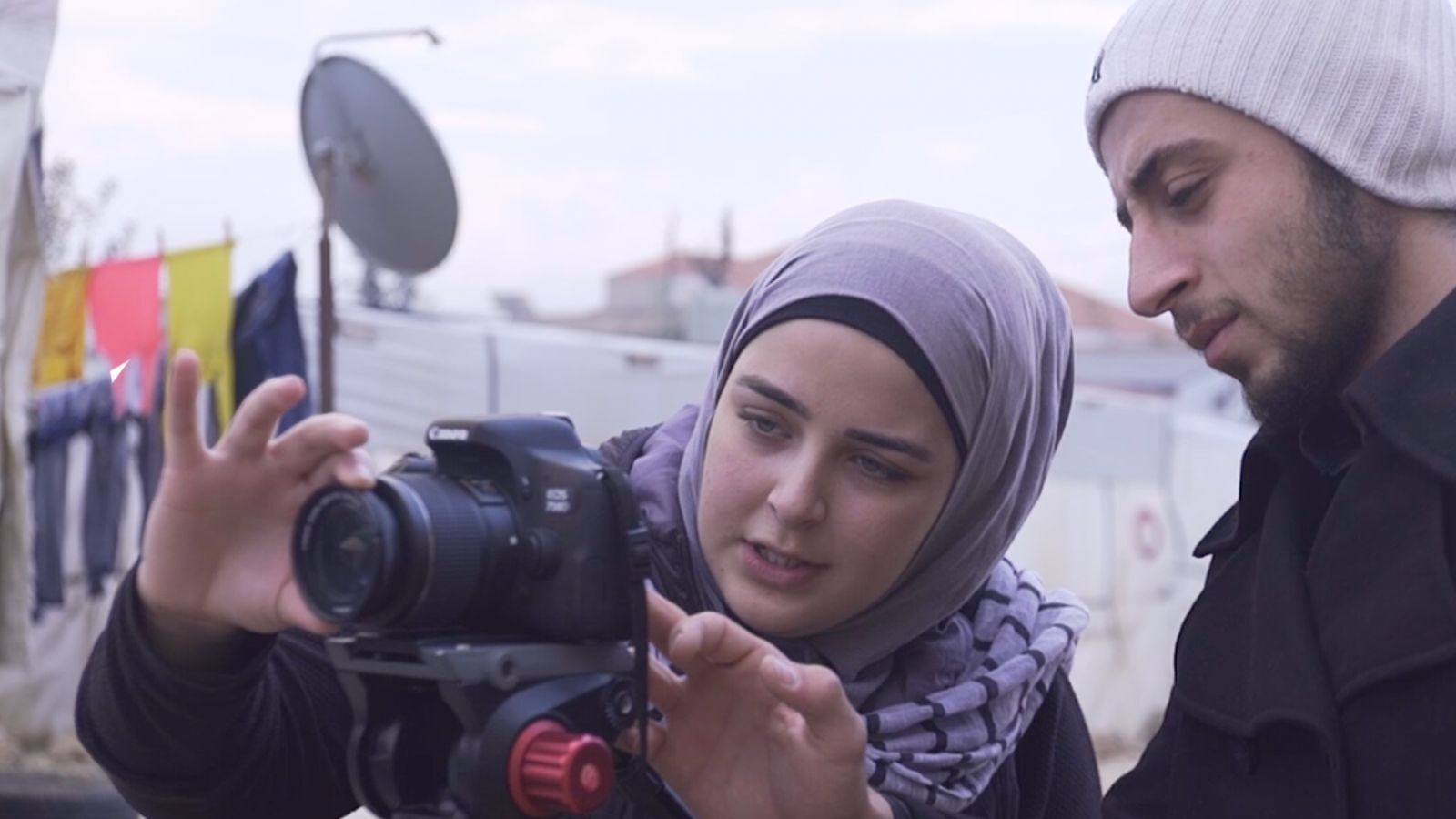The FIRE Journey of Action for Hope

Two people work on visual media media projects with Action for Hope.
Summary
“When we put arts and culture at the centre of social change processes, we are catalyzing a landscape of hope.” – Basma El Husseiny, Executive Director
Action for Hope’s work is at the crossroads of arts and social change in the Arab region. Its mission is formed from the belief that arts and culture have a role in empowering individuals and communities, particularly those in distress. The organization does this by providing people with access to culture and tools for creative expression to enrich their lives, thus increasing the cultural capital of communities around them, and enabling their contribution to our shared humanity.
Action for Hope was founded in 2015 in Beirut by artists and activists. Working in Lebanon and Syria, it started as a response to the drastic consequences of the conflict in Syria and to the cultural, social, and psychological needs of the resulting distressed and displaced communities. Action for Hope pioneered unique cultural relief programs and designed models in arts education and artistic production for refugee and marginalized communities, to give voice to their artists as well as a stage to tell their stories.
Within just a few years, the organization began to get requests to expand in the region, to support similarly impacted communities. Action for Hope realized that they needed a new strategic model if they were to become a catalyst and resource for other organizations. Rather than create more offices for their own organization, they wanted to empower new groups to do the work and model it to their own context. This meant investing in the development of training modules and materials that would allow other organizations to set up their own programs. Action for Hope entered the FIRE program with questions about how to fund this growth. How could they create the reach and impact needed in new communities in a way that maintained the grassroots integrity of their original work? And how could they make it financially resilient?
The FIRE program provided space for Action for Hope team to discuss and explore together. It showed the organization’s leadership, including a key board member, how to realize this ambitious goal in a financially resilient way.
Taking their direction from their organization’s financial dashboard, Board and staff worked together to chart a path forward. Action for Hope took bold action to build their first capital reserves, strengthen their fundraising capacity in the hiring of a Grants Manager, and develop a powerful new resource mobilization strategy.
Learn more about their story by checking out this blog, video and infographic below. This Impact Story from the Financial Innovation and Resilience (FIRE) program was created in February 2020.
Action for Hope: History and Mission
Action for Hope got its start in the summer of 2013. When several artists and activists visited Syrian refugee camps to show the solidarity of the Arab cultural community with the Syrian people in crisis, they brought donations to the camps and shared their skills with camp residents through some impromptu cultural workshops or events.
Visiting these communities made a deep impact on the members of this delegation and revealed two important truths: that displacement into the camps had a dehumanizing and demoralizing effect due to the disintegration of the whole social fabric, and that existing relief efforts were not addressing the whole human cost of the displacement. Among the delegation was Basma El Husseiny, the founder of Culture Resource, the first non-governmental regional cultural organization in the Arab region. With the development of initial funding, she then took on the leadership of a new initiative soon named Action for Hope.
The goals of Action for Hope are to integrate cultural activities into the lives of people in distressed and displaced communities. The organization provides artistically talented young people, children, and women with the skills, knowledge, and tools needed to communicate and document their stories, express themselves freely and creatively, and work professionally in the arts. Their efforts not only contribute but also preserve the cultural heritage of people who have been displaced from their homes. This work makes Action for Hope an actor in the conversations and collaborations that address the challenges that marginalized communities face.
“The need to express ourselves in a creative way, is innate to human beings. It’s true for everyone and especially groups who are undergoing deep crises. It’s necessary that they have the stages, tools, and production and to have a voice. Not just for their own mental health. It’s also their right to tell their own stories.” – Chiara Condoleo, Grants Manager
Action for Hope’s programs include the development of music schools, advanced training in video and theater, as well as university scholarships in the arts. Since its inception, transformative, life-changing experiences have been made possible for participants.
“We believe in the role of arts and culture in empowering people” – Sara Zein, Program Manager
Action for Hope before FIRE
After a few years of being an ‘on the ground’ responder, the Action for Hope team realized that demand for their services went well beyond Lebanon and Syria. Everywhere in the region where communities were subject to economic injustices and without access to arts and culture, there was a demand for their work.
Action for Hope became a Ford Foundation Build grantee in 2017. Soon after, they began to think about a strategic way to respond to the requests for expansion. For them the solution wasn’t more money, programs, schools, or new Action for Hope field offices in more countries: they wanted to become a resource and catalyst to help other organizations develop similar work in the region.
The organization entered the FIRE program with goals of raising funds for investments that would join, support and train others. As well, they are creating resource materials, communication tools and media, education programs that will extend to ‘train the trainer’ workshops, and a renovated website to create a centralized programming hub. This approach maintains their core mission that began at a grassroots level and continues to support the needs of the individuals and communities that they serve.
What FIRE Made Possible:
The FIRE program, undertaken by Action for Hope in 2020 – 2021, sparked a change in the financial culture of the organization. It has given them momentum towards change and a vision of a new strategic model.
There are five compelling moments of transformation in their FIRE Journey:
#1: Bringing the Board on the Journey
The leadership of Action for Hope understood that as part of activating their new strategic model, they would be asking their board members to approve new funding approaches and goals. To assist in the understanding of the evolution of the organization’s finances, they invited a board member to join them for the entirety of the FIRE program.
As Action for Hope’s Board Treasurer, Brigitte Boulad, took part in FIRE training, she became an early champion for the FIRE recommendations. Together with the staff, she learned about financial health indicators and reflected on the organization’s Financial Dashboard. Her active participation made the FIRE recommendations more accessible for other board members, and she was able to develop board support for new policies, in particular the reserve policy. As a result, the organization did not have to make a large investment in educating their board and were able to move quickly to create changes.
“Hearing from Brigitte was the best way to engage the board and have their buy-in. Her commitment will also help us develop our communication around our new practices.”
- Basma El Husseiny, Executive Director
#2: Aligning all the team around the FIRE Financial Dashboard
The Action for Hope team identified their financial systems as a key priority in the FIRE program. They had systems, but they were not able to generate timely and accurate reports to support the management of their programs.
FIRE’s Dashboard allows organizations to understand their state of financial health, by providing six important ‘wellness’ metrics:

Looking at their financial health through the lens of the FIRE Dashboard, the Action for Hope team immediately saw opportunities to grow their financial resilience. In areas where they were in the ‘red’ zone, such as capital reserves and resource mobilization investment, the dashboard showed them where they needed to focus to be in the ‘green’ zone.
“There is so much power in a dashboard. It helps their organization and helps them plan their future. The financial manager said “wow” – I’m going to use this right away’ - Amany Alhadka, Spring
The Dashboard’s Financial Indicators and newly developed strategic budget tools created transparency for all costs and revenues. This transparency fostered ownership and helped all team members be aware of their situation.
“It’s simple to use, and the fastest way to identify trends that lead to better decisions. This (dashboard) tool reveals opportunities: it shows instead of tells.” Ghassan Rahal, Finance Manager
“What struck me (about these tools) was that it was presented as a whole: one aspect linked to the other in a comprehensive chain. It made me aligned with the mission and vision and implementation of the organization. It made me feel that we can be flexible with money, and we can be ready to read new situations.” – Brigitte Boulad, Action for Hope, Board Treasurer
#3: Reserve Funds create a Stable Foundation
Before the FIRE program, Action for Hope did not have capital reserves, also called LUNA (Liquid Unrestricted Nets Assets). Not having reserves poses a real risk to the stability of the organization, including continuity of the work.
“FIRE helped us to develop a reserve policy. We had never thought about this before. We were fundraising all the time and didn’t think about having a reserve for emergencies.” – Basma El Husseiny, Executive Director
Since the training, the Action for Hope team has had a shift in mindset and has built a reserve fund of over half a million dollars. Understanding the strategic importance of capital reserves was one of the most important learnings from the FIRE program. The Action for Hope team began to understand that this investment could be transformative for the organization. They realized a reserve fund wasn’t just for crises or emergencies: rather it provided a solid financial foundation for the organization and long-term stability. With greater security and independence, they can confidently plan, and invest in the future.
“We learned what a reserve fund could do and how we could invest our money. Now thanks to FIRE we have an operational reserve, an emergency reserve, and a staff protection reserve” - Basma El Husseiny, Executive Director
The team also incorporated the continued growth of reserves into the goals of the resource mobilization strategy: future grant proposals will indicate that 5% of the funds will be allocated to reserves.
#4: Investing in Resource Mobilization
For Action for Hope, their experience with the FIRE program revealed a new opportunity about how to better mobilize resources. Prior to FIRE, the operating team struggled to make time for fundraising: donor relationships and grant administration had been managed by the Executive Director together with Finance and Program Leads. It was not a designated responsibility or priority of any team member and with everyone stretched with their other activities, fundraising progressed slowly.
The FIRE training team suggested hiring for a new role - a Grants Manager. This role would be the central co-ordinator of fundraising efforts, responsible for the planning of resource mobilization efforts, management of donor relations and grant reporting requirements. This would allow for a dedicated and consistent effort for nurturing donor relationships and strategically planning applications for specifically targeted funds and donors.
“A new Grants Manager was hired to ensure organizational sustainability, increase capacity, and to make resource mobilization more valuable.” Ghassan Rahal, Finance Manager
This new role created a paradigm shift in resource mobilization for Action for Hope. The Grants Manager led the strategy and deployed the activities to engage donors, track activities and monitor progress. The rest of the team contributed according to their areas of expertise.
Rather than creating a silo for this effort, it served to make resource mobilization a higher priority for everyone and underscored its importance to ensure the organization’s financial resilience.
“With FIRE, we learned that fundraising was not just one person’s work. Now we think as a team. We need to do fundraising together.” – Chiara Condoleo, Grants Manager
#5: A New Resource Mobilization Strategy
“We got good advice about the importance of planning resource mobilization. Rather than think ‘I just need money’, make a clear plan about resources you need to reach your goals. Focus on them and research what donors will help you get there, rather than chasing everything.” – Chiara Condoleo, Grants Manager
The FIRE program teaches that the best results in raising money come with a clear strategy and plan and a budget for executing it. This idea was a big breakthrough for Action for Hope.
The FIRE Diagnostic Tool showed them that they were not in the danger zone regarding donor dependency - their largest donor constituted 29% of their revenue – but they learned that they needed to be vigilant about diversification. Learning about the experiences of other groups in the cohort, they considered focusing more attention on opportunities with individual donors and encouraging potential earnings from consultancies and other possible sources of earned income.
By the end of the FIRE training, they were able to articulate and activate a clear resource mobilization strategy. As a first step in changing the conversation with donors they are committed to asking for what they truly need from their donor partners, starting with core support. Action for Hope began the FIRE program with just over 30% of funding considered unrestricted: now they are making specific requests to donors to increase this percentage. The team is also asking for increased amounts from current funders and is prioritizing donors who can provide multi-year funding, rather than those who offer only six or twelve-month contracts.
“We are looking for donors who will cover our core support costs. This will give us the freedom to make the necessary changes. The circumstances in the region are constantly changing so we need the core support. We are going to focus our work on the right funders who are willing to support us and believe in what we do.” – Chiara Condoleo, Grants Manager
FIRE has enabled a profound culture change in the Action for Hope organization: the team now understands that financial resilience can serve the values of the organization. With intentional engagement and showing the purpose behind their fundraising requests, they are engaging with donors as partners in their mission.
“I think of money as a useful tool to change reality. I think of money as a public resource. I don’t think of it as belonging to the donor. They do not own it but rather they are managing it on behalf of society. When we ask the donor for money, we ask the donor to give it to us on behalf of the society.”- Basma El Husseiny, Executive Director
Going Forward
Action for Hope wants to continue to create change through supporting cultural activity in the Arab region, as well as impact the lives of many artists.
“A large number have graduated from our programs after getting needed skills to work in the arts. We have more than 100 graduates from the music school and 60 from the film school. Dozens of graduates have been able to get jobs. Some have been able to continue their studies in countries where they are settling.” – Sara Zein, Program Manager
The building blocks of financial resilience are making it possible for the organization to scale their activities and be a significant resource and catalyst organization in the Arab region. With the guardrails of the FIRE tools, the Action for Hope team is confident that they will be able to increase the organization’s impact strategically and sustainably.
Over the next three years, the team will build resources to accelerate their ability to provide training, research, materials, and networking to communities that are creating programs using the Action for Hope models. Their aspiration is that their work has impact in Egypt and Turkey in 2023 and soon in Iraq and Sudan as well. What matters most for Action for Hope is that their future vision for growth is the same one that it started out with: to succeed, growth needs to be guided by the needs of the communities.
Action for Hope has also been inspired to grow their leadership in a new program dedicated to influencing social change in Global South countries across the world, beyond the Arab region. With the ambition of establishing a network across a broad international landscape, this program is appropriately called Landscapes of Hope. Its vision is to establish cross sector collaboration, including cultural sectors to work issues around human rights and inclusion. Landscapes of Hope supports research and training, grant-making, and the development of supporting networks within countries. As well, the Landscapes of Hope team hosts an annual international event called Requiem for Justice, which combines artistic performances with advocacy.
“The future is more clear and secure, because our financial future is healthier.” - Ghassan Rahal, Finance Manager
The FIRE program (Financial Innovation and Resilience) was developed by Spring and is made possible by the Ford Foundation. FIRE is an internationally renowned program that teaches the fundamentals of financial resilience. It includes the latest approaches in innovative financing models, transformative partnerships with funders, changing funding and investment landscape, resource development and diversification, strategic finance, external communications, and leadership practice.
This is one of several multi-media FIRE Impact Stories. The FIRE Impact Stories describe and illustrate key moments of transformation that took place during the FIRE program journeys of selected organizations.
Tags:
FIREFebruary 17, 2022


